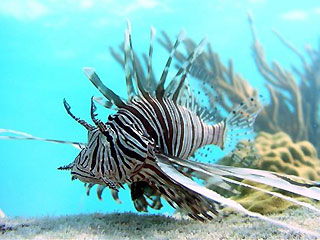
There is a threat to the ecosystem of the Caribbean, and it is multiplying rapidly. The lionfish, or more exactly the red lionfish, is a maroon striped fish with venomous spikes, and it is busy swallowing native species (the lionfish is not native to the area), stinging divers, and potentially destroying an ecologically delicate region.
The highly adaptable predator is able to swallow fish and crustaceans up to half its own size in one gulp. The fish's fins serve to corner its prey, which is proving to be very effective. And they are hungry – research teams have observed one lionfish eating 20 small fish in less than 30 minutes.
The red lionfish have invaded the area of the Caribbean from the costs of Cuba and Hispaniola to Little Cayman's pristine Bloody Bay Wall. According to Mark Hixon, an Oregon State University marine ecology expert who compared lionfish to a plague of locusts,
This may very well become the most devastating marine invasion in history. There is probably no way to stop the invasion completely.
The red lionfish is thought to have been introduced into the Atlantic in 1992, when Hurricane Andrew was responsible for shattering a private aquarium and releasing six of them into Miami's Biscayne Bay. Once in the ocean, it is thought that the fish released floating sacs of eggs, which rode the Gulf Stream north leading to colonization of deep reefs off North Carolina and Bermuda. Since the Bahamas are not the native area for the lionfish, it has no natural predators in the area. A fact that has allowed the lionfish unbridled growth in the Bahamas.
The lionfish has been spotted in virtually every oceanic habitat, including shallow and deep reefs, off piers and beaches, and even in baby fish laden mangrove thickets.
According to Pineiro-Soler of the Caribbean Fishery Management Council it would be devastating if the fish reached fisheries and recreational areas of Puerto Rico and the U.S. Virgin Islands. The request has been sent out for fishermen to capture the lionfish, and divers are reporting concentrated areas for eradication.
The slow moving lionfish measure about 18 inches, and is easy to snare. But the depths at which it swims is too deep for divers. Attempts to get sharks and moray eels to eat the lionfish has mostly proven to be non-effective. According to Andy Dehart of the National Aquarium in Washington,
If we start losing these smaller reef fish as food to the lionfish … we could be in a whirlwind for bad things coming to the reef ecosystem.
via (picture:AP/Oregon State University)



